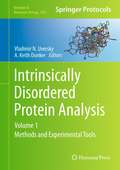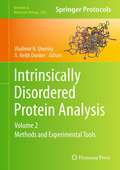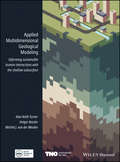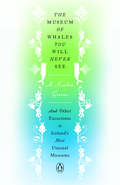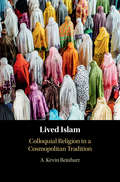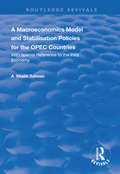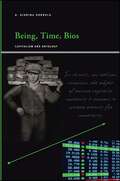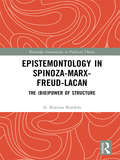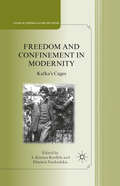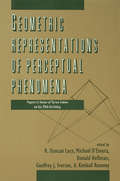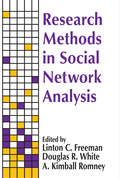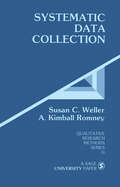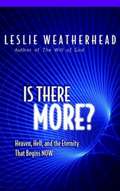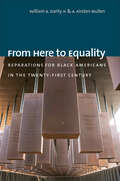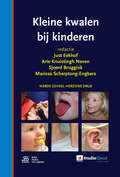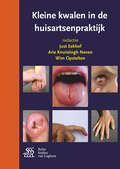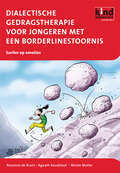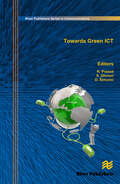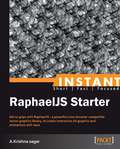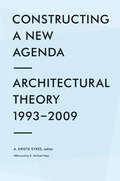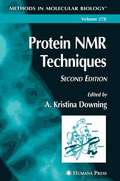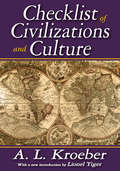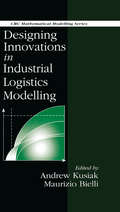- Table View
- List View
Intrinsically Disordered Protein Analysis, Volume 1, Methods and Experimental Tools
by Vladimir N. Uversky A. Keith DunkerOver the past decade, there has been an explosive development of research of intrinsically disordered proteins (IDPs), which are also known as unfolded proteins. Structural biologists now recognize that the functional diversity provided by disordered regions complements the functional repertoire of ordered protein regions. In Intrinsically Disordered Protein Analysis :Methods and Experimental Tools, expert researchers explore the high abundance of IDPs in various organisms, their unique structural features, numerous functions, and crucial associations with different diseases. Volume 1 includes sections on assessing IDPs in the living cell,NMR based techniques, vibrational spectroscopy, and other spectroscopic techniques. Written in the highly successful Methods in Molecular BiologyTM series format, the chapters include the kind of detailed description and implementation advice that is crucial for getting optimal results in the laboratory. Thorough and intuitive, Intrinsically Disordered Protein Analysis: Methods and Experimental Tools helps scientists further their investigations of these fascinating and dynamic molecules.
Intrinsically Disordered Protein Analysis, Volume 2, Methods and Experimental Tools
by Vladimir N. Uversky A. Keith DunkerOver the past decade, there has been an explosive development of research of intrinsically disordered proteins (IDPs), which are also known as unfolded proteins. Structural biologists now recognize that the functional diversity provided by disordered regions complements the functional repertoire of ordered protein regions. In Intrinsically Disordered Protein Analysis: Methods and Experimental Tools, expert researchers explore the high abundance of IDPs in various organisms, their unique structural features, numerous functions, and crucial associations with different diseases. Volume 2 includes sections on single molecule techniques, methods to assess protein size and shape, analyzing conformational behavior, mass-spectrometry, expression and purification of IDP's. Written in the highly successful Methods in Molecular BiologyTM series format, the chapters include the kind of detailed description and implementation advice that is crucial for getting optimal results in the laboratory. Thorough and intuitive, Intrinsically Disordered Protein Analysis: Methods and Experimental Tools helps scientists further their investigations of these fascinating and dynamic molecules.
Applied Multidimensional Geological Modeling: Informing Sustainable Human Interactions with the Shallow Subsurface
by A. Keith TurnerOver the past decades, geological survey organizations have digitized their data handling and holdings, unlocking vast amounts of data and information for computer processing. They have undertaken 3-D modeling alongside, and in some cases instead of, conventional geological mapping and begun delivering both data and interpretations to increasingly diverse stakeholder communities. Applied Multidimensional Geological Modeling provides a citable central source that documents the current capabilities and contributions of leading geological survey organization and other practitioners in industry and academia that are producing multidimensional geological models. This book focuses on applications related to human interactions with conditions in the shallow subsurface, within 100-200 m of the surface. The 26 chapters, developed by 100 contributors associated with 37 organizations, discuss topics relevant to any geologist, scientist, engineer, urban planner, or decision maker whose practice includes assessment or planning of underground space.
No Less Strange or Wonderful: Essays
by A. Kendra GreeneRevelatory. . . . Prepare yourself to be dazzled.” —Ben Fountain, author of Devil Makes Three Exploding sharks, trees riding bicycles, a Hollywood-esque balloon dress, a giant sloth in costume, a stolen woodpecker, and a sentient bag of wasps—and remember: this is nonfiction. Celebrated author and artist A. Kendra Greene’s No Less Strange or Wonderful is a brilliant and generous meditation—on the complex wonder of being alive, on how to pay attention to even the tiniest (sometimes strangest) details that glitter with insight, whimsy, and deep humanity, if only we’d really look. In twenty-six sparkling essays, illuminated through both text and image, Greene is trying to make sense—of anything, really—but especially the things that matter most in life: love, connection, death, grief, the universe, meaning, nothingness, and everythingness. Through a series of encounters with strangers, children, and animals, the wild merges with the domestic; the everyday meets the sublime. Each essay returns readers to our smallest moments and our largest ones in a book that makes us realize—through its exuberant language, its playful curation, and its delightful associative leapfrogging—that they are, in fact, one in the same.
The Museum of Whales You Will Never See: And Other Excursions to Iceland's Most Unusual Museums
by A. Kendra GreeneMythic creatures, natural wonders, and the mysterious human impulse to collect are on beguiling display in this poetic tribute to the museums of an otherworldly island nation.Iceland is home to only 330,000 people (roughly the population of Lexington, Kentucky) but more than 265 museums and public collections--nearly one for every ten people. They range from the intensely physical, like the Icelandic Phallological Museum, which collects the penises of every mammal known to exist in Iceland, to the vaporously metaphysical, like the Museum of Icelandic Sorcery and Witchcraft, which poses a particularly Icelandic problem: How to display what can't be seen? In The Museum of Whales You Will Never See, A. Kendra Greene is our wise and whimsical guide through this cabinet of curiosities, showing us, in dreamlike anecdotes and more than thirty charming illustrations, how a seemingly random assortment of objects--a stuffed whooper swan, a rubber boot, a shard of obsidian, a chastity belt for rams--can map a people's past and future, their fears and obsessions. "The world is chockablock with untold wonders," she writes, "there for the taking, ready to be uncovered at any moment, if only we keep our eyes open."
Lived Islam: Colloquial Religion In A Cosmopolitan Tradition
by A. Kevin ReinhartDoes Islam make people violent? Does Islam make people peaceful? In this book, A. Kevin Reinhart demonstrates that such questions are misleading, because they assume that Islam is a monolithic essence and that Muslims are made the way they are by this monolith. He argues that Islam, like all religions, is complex and thus best understood through analogy with language: Islam has dialects, a set of features shared with other versions of Islam. <P><P> It also has cosmopolitan elites who prescribe how Islam ought to be, even though these experts, depending on where they practice the religion, unconsciously reflect their own local dialects. Reinhart defines the distinctive features of Islam and investigates how modernity has created new conditions for the religion. Analyzing the similarities and differences between modern and pre-modern Islam, he clarifies the new and old in the religion as it is lived in the contemporary world.
A Macroeconomics Model and Stabilisation Policies for the OPEC Countries: With Special Reference to the Iraqi Economy (Routledge Revivals)
by A. Khalik SalmanFirst published in 1999, this book focuses on the macroeconomics issues which directly affect OPEC countries, aiming to set them in the context of the overall development effort. The most extant theoretical and empirical aspects in macroeconomics are integrated smoothly with institutional issues and policy questions. The analysis is illustrated through examples to show how the theories relate to the real world, especially to ongoing debates on developing economies as well as debates that encompass both developing and OPEC and developed countries.
Being, Time, Bios: Capitalism and Ontology (SUNY series, Insinuations: Philosophy, Psychoanalysis, Literature)
by A. Kiarina KordelaAlthough both share a focus on human life as it is inscribed by power, Foucauldian biopolitics and Lacanian psychoanalysis have remained isolated from and even opposed to one another. In Being, Time, Bios, A. Kiarina Kordela aims to overcome this divide, formulating a historical ontology that draws from Spinoza, Marx, Heidegger, and Sartre to theorize the changed character of "being" and "time" under secular capitalism. With insights from film theory, postcolonial studies, and race theory, Kordela's wide-ranging analysis suggests a radically new understanding of contemporary capitalism—one in which uncertainty, sacrifice, immortality, and the gaze are central.
Epistemontology in Spinoza-Marx-Freud-Lacan: The (Bio)Power of Structure (Routledge Innovations in Political Theory)
by A. Kiarina KordelaA. Kiarina Kordela steps beyond extant commentaries on Marx’s theory of commodity fetishism—from A. Sohn-Rethel to L. Althusser, É. Balibar, Slavoj Žižek, and others—to show that in capitalism value is the manifestation of the homology between thought and being, while their other aspect—power—is foreclosed and becomes the object of biopower. Using monistic Marxian/Lacanian structuralism as an alternative to dominant models from Plato and Kant to phenomenological accounts, deconstruction, and other contemporary approaches, Kordela expertly argues that Marx’s theory of commodity fetishism is a reformulation of the Spinozian thesis that thought (mind) and things (bodies or extension) are manifestations of one and the same being or substance. Kordela’s link between Spinoza and Marx shows that being consists of two aspects, value and power, the former leading to structuralist thought, the latter becoming the object of contemporary biopower. Epistemontology in Spinoza-Marx-Freud-Lacan intervenes between two dominant lines of thought in the reception of Marx today: on the one hand, an approach that relates Marxian thought to psychoanalysis from a Hegelian/dialectical perspective and, on the other hand, an approach that links Marxism to Spinozian monism, at the total exclusion of psychoanalysis.This book will interest scholars and researchers who study Marxism, (post)structuralism, psychoanalysis, critical theory, ontology, epistemology and theories of representation, theoreticians of cultural studies and comparative literature, aesthetic theory, including the relation of art to economy and politics, and biopolitics.
Freedom and Confinement in Modernity
by Dimitris Vardoulakis A. Kiarina KordelaKafka's literary universe is organized around constellations of imprisonment. Freedom and Confinement in Modernity proposes that imprisonment does not signify a tortured state of the individual in modernity. Rather, it provides a new reading of imprisonment suggesting it allows Kafka to perform a critique of a modernity instead.
Geometric Representations of Perceptual Phenomena: Papers in Honor of Tarow indow on His 70th Birthday
by R. Duncan Luce A. Kimball Romney Donald Hoffman Geoffrey J. Iverson Michael DBased on a conference held in honor of Professor Tarow Indow, this volume is organized into three major topics concerning the use of geometry in perception: * space -- referring to attempts to represent the subjective space within which we locate ourselves and perceive objects to reside; * color -- dealing with attempts to represent the structure of color percepts as revealed by various experimental procedures; and * scaling -- focusing on the organization of various bodies of data -- in this case perceptual -- through scaling techniques, primarily multidimensional ones. These topics provide a natural organization of the work in the field, as well as one that corresponds to the major aspects of Indow's contributions. This book's goal is to provide the reader with an overview of the issues in each of the areas, and to present current results from the laboratories of leading researchers in these areas.
Research Methods in Social Network Analysis
by A. Kimball Romney Linton C. Freeman Douglas R. WhiteSince the publication of Herbert Spencer's Principles of Sociology in 1875, the use of social structure as a defining concept has produced a large body of creative speculations, insights, and intuitions about social life. However, writers in this tradition do not always provide the sorts of formal definitons and propositions that are the building blocks of modern social research. In its broad-ranging examination of the kind of data that form the basis for the systematic study of social structure, Research Methods in Social Network Analysis marks a significant methodological advance in network studies.As used in this volume, social structure refers to a bundle of intuitive natural language ideas and concepts about patterning in social relationships among people. In contrast, social networks is used to refer to a collection of precise analytic and methodological concepts and procedures that facilitate the collection of data and the systematic study of such patterning. Accordingly, the book's five sections are arranged to address analytical problems in a series of logically ordered stages or processes.The major contributors define the fundamental modes by which social structural phenomena are to be represented; how boundaries to a social structure are set; how the relations of a network are measured in terms of structure and content; the ways in which the relational structure of a network affects system actors; and how actors within a social network are clustered into cliques or groups. The chapters in the last section build on solutions to problems proposed in the previous sections. This highly unified approach to research design combined with a representative diversity of viewpoints makes Research Methods in Social Network Analysis a state-of-the-art volume.
Systematic Data Collection
by Dr Susan C. Weller A. Kimball RomneyData collection in the field, whether by interviewing or other methods, can be carried out in a structured, systematic and scientific way. This volume compels field researchers to take very seriously not only what they hear, but what they ask. Ethnographers have often discovered too late that the value of their interview information is discounted as a consequence of poor sampling (of both questions and informants) and poor elicitation techniques. The authors focus on the importance of establishing the right questions to ask through the use of free listing techniques; then they describe in practical terms the administration of an impressive array of alternative kinds of informant task. They conclude with a discussion of reliability and validity of various methods which can be used to generate more systematic, culturally meaningful data.
Is There More?: Heaven, Hell, and the Eternal Life that Begins Now
by Leslie D. Weatherhead A. Kingsley WeatherheadThink you know everything there is to know about the life that lies beyond this one? Think again. Questions about life beyond death are always with us. In this classic volume, Leslie Weatherhead answers personal and important questions about heaven, hell, and the future God has in store for us."Eternal life is . . . a quality and not just a quantity; . . . a quality of communion with God that clearly begins now. You know, people talk about the afterlife and they say, ‘He’s gone to be with God.’ But he has always been with God, and the highest heaven doesn’t mean that God exists in any fuller measure. It can only mean that our power of communion deepens. But one of the marvelous things about the Christian gospel is that the offer of eternal life is here and now." –from chapter 1Check out other resources by Dr. Weatherhead, including The Will of God, in the Related Products Section below.
From Here to Equality: Reparations for Black Americans in the Twenty-First Century
by William A. Darity A. Kirsten MullenRacism and discrimination have choked economic opportunity for African Americans at nearly every turn. At several historic moments, the trajectory of racial inequality could have been altered dramatically. Perhaps no moment was more opportune than the early days of Reconstruction, when the U.S. government temporarily implemented a major redistribution of land from former slaveholders to the newly emancipated enslaved. But neither Reconstruction nor the New Deal nor the civil rights struggle led to an economically just and fair nation. Today, systematic inequality persists in the form of housing discrimination, unequal education, police brutality, mass incarceration, employment discrimination, and massive wealth and opportunity gaps. Economic data indicates that for every dollar the average white household holds in wealth the average black household possesses a mere ten cents. In From Here to Equality, William Darity Jr. and A. Kirsten Mullen confront these injustices head-on and make the most comprehensive case to date for economic reparations for U.S. descendants of slavery. After opening the book with a stark assessment of the intergenerational effects of white supremacy on black economic well-being, Darity and Mullen look to both the past and the present to measure the inequalities borne of slavery. Using innovative methods that link monetary values to historical wrongs, they next assess the literal and figurative costs of justice denied in the 155 years since the end of the Civil War. Finally, Darity and Mullen offer a detailed roadmap for an effective reparations program, including a substantial payment to each documented U.S. black descendant of slavery. Taken individually, any one of the three eras of injustice outlined by Darity and Mullen--slavery, Jim Crow, and modern-day discrimination--makes a powerful case for black reparations. Taken collectively, they are impossible to ignore.
Kleine kwalen bij kinderen
by J.A.H. Eekhof A. Knuistingh Neven S. C. Bruggink M.J. Scherptong-EngbersDit boek biedt een uitgebreid overzicht van typische kleine en meestal onschuldige kwalen die bij kinderen voorkomen, zoals krentenbaard, platvoeten en waterpokken. Daarmee onderscheidt dit boek zich van andere boeken over kindergeneeskunde, waarin vooral aandacht is voor ernstige aandoeningen.Van alle 160 aandoeningen worden etiologie, diagnostiek, beleid en beloop beschreven. De vele foto's tonen de kenmerken van de verschillende aandoeningen en verduidelijken daarmee de tekst.In 2009 is Kleine kwalen bij kinderen geheel herzien met veel nieuw beeldmateriaal en nieuwe hoofdstukken. De opmaak heeft de bruikbaarheid verbeterd. Waar mogelijk wordt verwezen naar informatiemateriaal voor ouders en verzorgers.Kleine kwalen bij kinderen is geschreven volgens dezelfde opzet als het succesvolle boek Kleine kwalen in de huisartspraktijk. Hoewel het boek in de eerste plaats geschikt is voor huisartsen en huisartsen in opleiding, consultatiebureauartsen, jeugdartsen en kinderartsen, biedt het ook waardevolle informatie voor andere medische professionals die met kinderen werken.De inhoud van dit boek sluit aan bij de richtlijnen van het Nederlands Huisartsen Genootschap.
Kleine kwalen in de huisartsenpraktijk
by J.A.H. Eekhof A. Knuistingh Neven W. OpsteltenDit boek beschrijft de diagnostiek en behandeling van ruim 200 aandoeningen die veel voorkomen in de huisartsenpraktijk. Het zijn relatief onschuldige aandoeningen, waarbij uitleg en een eenvoudig advies dikwijls volstaan. Er wordt echter tijdens de medische opleiding weinig aandacht aan besteed en vaak zien artsen in opleiding deze aandoeningen pas voor het eerste tijdens een stage in de huisartsenpraktijk. De diagnostiek en het beleid zijn voorzien van een rationele en, zo mogelijk, een wetenschappelijke onderbouwing. De inhoud van dit boek sluit aan bij de richtlijnen en standaarden van het Nederlands Huisartsen Genootschap (NHG). Aan de zesde, geheel herziene druk van Kleine kwalen in de huisartsenpraktijk zijn meer dan 30 nieuwe hoofdstukken toegevoegd (zoals de Eikenprocessierups en Zwemmersjeuk). Nieuw is ook dat elk hoofdstuk begint met kernpunten. Daardoor ziet de lezer in een oogopslag de belangrijkste aspecten van de aandoening. Daarnaast is aan vrijwel ieder hoofdstuk een illustratie toegevoegd. Kleine kwalen in de huisartsenpraktijk is bedoeld voor huisartsen, huisartsen in opleiding en medisch studenten. Het boek is echter ook waardevol voor andere artsen, praktijkondersteuners, physician assistants of klinische verpleegkundigen die in hun dagelijkse praktijk met kleine kwalen worden geconfronteerd. Naast Kleine kwalen in de huisartsenpraktijk zijn ook de volgende boeken verkrijgbaar: Kleine kwalen bij kinderen, over aandoeningen die specifiek bij kinderen voorkomen en Kleine kwalen en alledaagse klachten bij ouderen, over aandoeningen die specifiek bij ouderen voorkomen.
Dialectische gedragstherapie voor jongeren met een borderlinestoornis: Met het werkboek Surfen op emoties (Kind en adolescent praktijkreeks)
by Nicole Muller R. de Bruin A. KoudstaalJongeren met een borderline persoonlijkheidsstoornis of trekken ervan voelen zich vaak wanhopig, onbegrepen en niet in staat een leven op te bouwen dat ze als de moeite waard ervaren. Dit leidt tot constante emotionele ontregeling: woedeaanvallen, grote wanhoop, een negatief zelfbeeld, zelfbeschadiging of doodswensen, middelenmisbruik of ander impulsief gedrag en grote interpersoonlijke problemen. Hun risicovolle gedrag maakt hun omgeving, maar ook de betrokken hulpverleners, regelmatig machteloos. Zelf hebben ze vaak het gevoel nooit meer uit deze negatieve spiraal te kunnen komen.Wat weten we over borderline bij jongeren en mogen we die diagnose eigenlijk wel stellen op deze leeftijd? En zo ja, hoe doe je dat dan verantwoord? Maar vooral ook: welke behandeling is mogelijk voor deze jongeren? Hoe houden we hen gemotiveerd voor behandeling?Dit boek is een praktische gids voor wie de DGT-behandeling bij jongeren (12-21 jaar) wil toepassen. Met heldere voorbeelden worden principes en technieken belicht die in de behandeling voor borderline toe te passen zijn. Hoe ouders bij de behandeling kunnen worden betrokken, krijgt hierbij ook aandacht. In dit boek wordt sessie voor sessie de DGT-J-Vaardigheidstraining beschreven, waarbij veel suggesties voor rollenspelen en verwerkingsvormen worden aangeboden.Jongeren kunnen in de DGT-J-Vaardigheidstraining aan de slag met het bijbehorende werkboek Surfen op emoties.Dit protocol verschijnt in de 'Kind en Adolescent Praktijkreeks'. Een reeks met heldere en gefundeerde informatie over stoornissen en behandelmethoden voor kinder- en jeugdpsychologen, orthopedagogen, kinder- en jeugdpsychiaters en andere hulpverleners. In iedere uitgave komt een behandelmethode aan de orde.
Towards Green ICT (River Publishers Series In Communications Ser.)
by Homayoun Nikookar Peter Koch Ramjee Prasad Peter Gorm Larsen Peter Jung Masanori Hariyama Petar Popovski Dina Šimunić Yariv Taran Hiroyuki Morikawa Peter Lindgren Leo P. Ligthart Knud Erik Skouby Shingo Ohmori Dina Šimunic L. E. Mägi M. G. Gustafsson A. Kramers Hideaki Imaizumi Takeshi Mizuike Keizo Sugiyama Kishore Ramareddy Parag Pruthi Iwona Windekilde Christoph Spiegel Sebastian Rickers Woojin Shim Rami Lee Jae Hwang Yu Rasmus Krigslund Iskra Dukovska-Popovska Gert F. Pedersen Boris Manev Rasmus Hjorth Nielsen Albena Mihovska Ole Brun Madsen Alberto Nannarelli Nobuo Nakajima L. Jorguseski R. Litjens J. Oostveen H. Zhang John Rohde Sune Wolff Thomas Skjødeberg Toftegaard Kenneth Lausdahl Augusto Ribeiro Poul Ejnar Rovsing Masahide Sasaki Atsushi Waseda Masahiro Takeoka Mikio Fujiwara Hidema Tanaka Masahiro Umehira Michitaka Kameyama Hideaki Furukawa Naoya Wada Xiaohua Lian Kristin Saughaug Subria ClemensenICT is playing an increasingly important role in both business and individual's private life. It has increased international interconnectedness and speed up the process of globalization. But on the other side the total energy consumption by the communication and networking devices and the relevant global CO emission is increasing exponentially. ICT has, in many ways, a vital role to play. It accounts for about two percent of global CO emissions. Telecommunications applications can have a direct, tangible impact on lowering greenhouse gas emissions, power consumption, and achieve efficient recycling of equipment waste.This book is the outcome of the special session on Green Communications at 'The 12th International Symposium on Wireless Personal Multimedia Communications' (WPMC) held in September '09 in Sendai, Japan. To the best of the editors' knowledge this is the first book on the Green Information and Communication Technologies (ICT) and can be considered a milestone and a key-tool aimed at driving the industrial, scientific and academic efforts of the international community to guarantee a greener future to the whole planet.
Tracer Hydrology 97
by A. KranjcThis collection of papers is the proceedings of the 7th International Synosium on Water Tracing in Portoroz/Slovenia from 26-31 May 1997. They address a number of topics in hydrology tracing techniques including: protection of natural resources against pollution; the use of natural and artificial tracers to help to assess contaminant transport in surface waters; and aquifer parameters and modelling.
Instant RaphaelJS Starter
by A. Krishna SagarGet to grips with a new technology, understand what it is and what it can do for you, and then get to work with the most important features and tasks. Starter GuideThis book is great for developers new to Vector graphics in browsers (SVG and VML), and who are looking to get a good grounding in how to use Raphael JS to create imageless and fast loading interactive drawings and shapes, in a web browser. It's assumed that you will have some experience in HTML JavaScript or jQuery already.
Constructing a New Agenda: Architectural Theory 1993-2009
by A. Krista Sykes K. Michael HaysThis follow-up to Kate Nesbitt's best-selling anthology Theorizing a New Agenda collects twenty-eight essays that address architecture theory from the mid-1990s, where Nesbitt left off, through the present. Kristin Sykes offers an overview of the myriad approaches and attitudes adopted by architects and architectural theorists during this era. Multiple themes—including the impact of digital technologies on processes of architectural design, production, materiality, and representation; the implications of globalization and networks of information; the growing emphasis on sustainable and green architecture; and the phenomenon of the 'starchitect' and iconic architecture—appear against a background colored by architectural theory, as it existed from the 1960s on, in a period of transition (if not crisis) that centers around the perceived abyss between theory and practice. Theory's transitional state persists today, rendering its immediate history particularly relevant to contemporary thought and practice.While other collections of recent theoretical writings exist none attempt to address the situation as a whole, providing in one place key theoretical texts of the past decade and a half. This book provides a foundation for ongoing discussions surrounding contemporary architectural thought and practice, with iconic essays by Greg Lynn, Deborah Berke, Sanford Kwinter, Samuel Mockbee, Stan Allen, Rem Koolhaas, William Mitchell, Anthony Vidler, Micahel Hays, Reinhold Martin, Reiser + Umemoto, Glenn Murcutt, William McDonough, Micahael Braungart, Michael Speaks, and many more.
Protein NMR Techniques
by A. Kristina DowningThis collection of readily reproducible methods using the latest advances in NMR technology includes methods for high-level recombinant protein expression using sophisticated isotopic labeling strategies, TROSY methods for the study of structure and dynamics, and methods for the acquisition and interpretation of residual dipolar coupling data. There are also applications of dynamics measurements on multiple timescales, new developments in NMR data analysis, structure calculation protocols, and solid-state methods. The protocols follow the successful Methods in Molecular BiologyTM series format, each offering detailed laboratory instructions, an introduction outlining the principle behind the technique, lists of equipment and reagents, and tips on troubleshooting and avoiding known pitfalls.
Checklist of Civilizations and Culture
by A. KroeberChecklist of Civilizations and Culture contains all known principal civilizations and cultures of the world, with such definition as is possible of their area and time, their subdivisions and periods, and a brief indication of their character. The terms civilization and culture are used inclusively as essential synonyms of varying emphasis. There is no special difference between how the two words are used. They denote somewhat distinguishable grades of degree of the same large scale processes.Civilization currently carries an overtone of high development of a society; culture has become a customary term of universal denotation, applicable alike to high or low products and heritages of societies. This component or segment of culture or civilization is denoted here as ""value culture"" by A. L. Kroeber. It includes all purely aesthetic and intellectual activity as well as an element in every religion, and includes some part of morals, though morality is directed also to personal conduct and action.Every human society has its culture, complex or simple. The word culture should denote all possible ideals, but for the larger and richer cultures the term civilization may be more appropriate. Kroeber argues that the problem of recognizing the world's cultures is essentially one of natural history and involves dealing with all phenomena and then building up their patterns or classes step by step. This classic volume is now available in paperback. No better teacher of general anthropology can be imagined than A. L. Kroeber.
Designing Innovations in Industrial Logistics Modelling (Mathematical Modeling Ser.)
by A. Kusiak M. BielliDesigning Innovations in Industrial Logistics Modelling describes practical methods for approaching the task of designing industrial logistics systems. It surveys the development of logistics models and their application in manufacturing to designing, planning, and implementing the movement of supplies, equipment, and products. This text/reference book discusses the combination of operation and production research to obtain solutions for designing and integrating advanced logistics systems. It provides the reader with a set of prescriptive and descriptive models and methods that have been developed exclusively for the purpose of designing, managing, and optimizing the architecture of such advanced systems. The design and application of new tools and methods is presented in such a way that emphasizes the competitiveness of manufacturing industries, and case studies are presented in a manner that demonstrates successful models and methods in advanced industrial logistics systems. In addition, Designing Innovations in Industrial Logistics Modelling explains the various formal tools and methodologies employed in evaluating new programs and covers program management and dynamic evaluation techniques.
